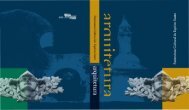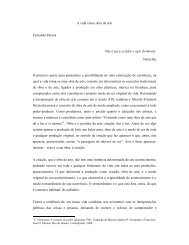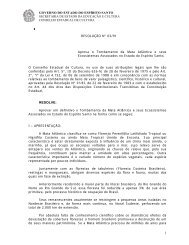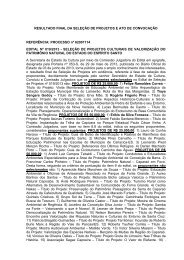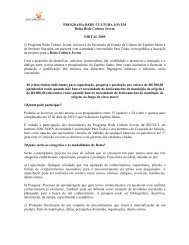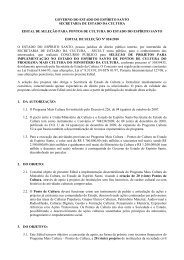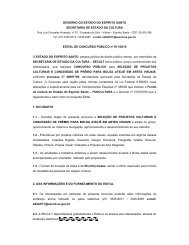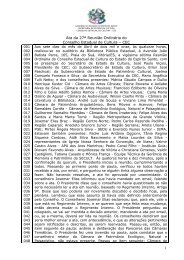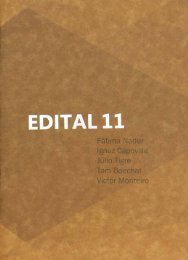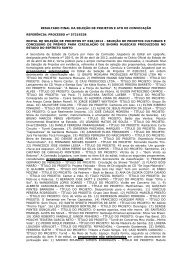Create successful ePaper yourself
Turn your PDF publications into a flip-book with our unique Google optimized e-Paper software.
Para nós do Estado do Espírito Santo é motivo de muito orgulho<br />
exibir esta mostra, no Museu da Casa Brasileira em São Paulo,<br />
por duas razões.<br />
A primeira deve-se ao fato de ser um projeto institucional. Tal iniciativa<br />
testemunha o compromisso da Secretaria de Estado da Cultura e<br />
do SEBRAE-ES com a política de preservação e revitalização dos<br />
nossos bens e valores culturais. A identidade cultural de um Estado<br />
se constrói a partir de sua história e da herança arquitetônica e<br />
simbólica legada por seus antepassados. Por isso, tão importante<br />
quanto restaurar e revitalizar as edificações que contam a nossa<br />
história, é conservar nossos bens culturais imateriais, incentivando<br />
o seu estudo e a sua prática.<br />
O Estado do Espírito Santo tem uma riqueza étnica ímpar, decorrente<br />
dos inúmeros imigrantes que <strong>aqui</strong> aportaram e mesclaram suas<br />
culturas de origem com os índios, negros africanos, italianos, alemães,<br />
pomeranos, sírios-libaneses, suíços, belgas, luxemburgueses,<br />
austríacos, holandeses, resultando numa pluralidade de ritmos,<br />
timbres, danças e elementos visuais expressos em seus folguedos<br />
originários, e releituras feitas por outras manifestações artísticas.<br />
Há um sentido místico religioso, de louvor, de sentimento coletivo<br />
na música, na coreografia e nas letras dos cantos. São enfim as<br />
folias de reis, os rei de boi, o tambor de São Benedito, as bandas<br />
de congo, o Ticumbi, o sabor da moqueca capixaba, privilegiado<br />
pelo mar, pelas montanhas, dunas e pelos manques. Celebrar esta<br />
diversidade e revelar a todos a beleza de nossa cultura tradicional<br />
e étnica é dever da Secretaria de Estado da Cultura.<br />
It is with great pride that we, the people of the state of Espírito<br />
Santo, present this exhibition at the Museu da Casa Brasileira in<br />
São Paulo, for two reasons:<br />
The first is due to the fact that this is an institutional project. Such<br />
an initiative confirms the commitment of the State Secretary of<br />
Culture and SEBRAE in Espírito Santo in their preservation and<br />
revitalization policy for our cultural property and values. The cultural<br />
identity of Espírito Santo has been constructed through its history<br />
and the architectural and symbolic heritage left by its forefathers.<br />
For this reason, as important as restoring and revitalizing buildings<br />
that tell our history is preserving our intangible cultural heritage,<br />
encouraging both research and practice.<br />
The state of Espírito Santo has unmatched ethnic wealth, resulting<br />
from innumerous immigrants that set up shop combining their<br />
original cultures with those of the Indigenous peoples, Africans,<br />
Italians, Germans, Poles, Belgians, people from Luxembourg,<br />
Austria, Holland, Switzerland, as well as Lebanese people,<br />
resulting in a mix of rhythms, tunes, dances and visual elements<br />
expressed in their original endeavors, and reinterpretations made<br />
by other forms of artistic manifestations. There are religious<br />
mystical meanings, of praise, of collective significance in the<br />
music, in the choreography and in the lyrics of the songs. They<br />
are, in reality, folias de reis, the reis de boi, the tambor of Saint<br />
Benedict, the conga bands, the Ticumbi dance, the flavor of the<br />
moqueca made in Espírito Santo, aided by the closeness of the<br />
sea, the mountains, the dunes and the mangrove. Celebrating this




